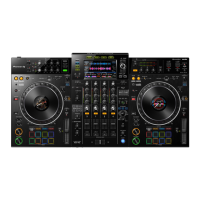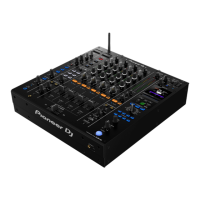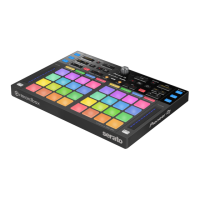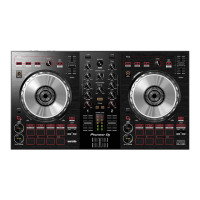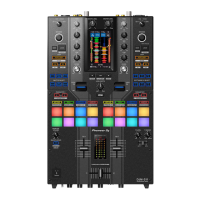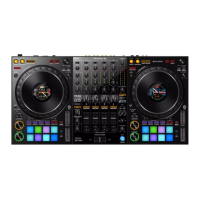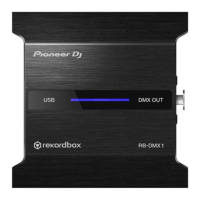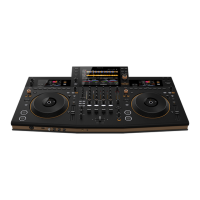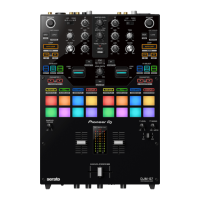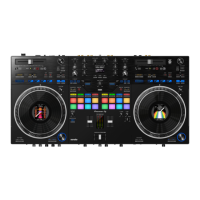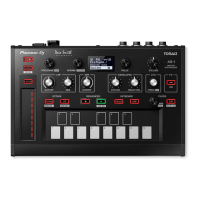
Do you have a question about the PIONEER DJ TORAIZ AS-1 and is the answer not in the manual?
| AC power voltage | 100 V to 240 V |
|---|---|
| AC power frequency | 50 Hz/60 Hz |
| Rated current | 0.4 A |
| Rated output voltage | DC 5 V |
| Rated output current | 2 A |
| Power consumption (standby) | 0.075 W |
| Power consumption | DC 5 V, 1500 mA |
| tolerable operating temperature range | +5 °C to +35 °C |
|---|---|
| tolerable operating humidity range | 5 % to 85 % |
| audio out R output terminal | 1/4˝ TS jack |
|---|---|
| audio out L output terminal | 1/4˝ TS jack |
| phones output terminal | 1/4˝ stereo phone jack |
| MIDI OUT/THRU output terminal | 5P DIN |
| MIDI IN input terminal | 5P DIN |
| trigger IN input terminal | 1/4˝ TS jack |
| USB terminal | B type |
| weight | 1.4 kg |
|---|---|
| width | 267.4 mm |
| height | 68.6 mm |
| depth | 177.7 mm |
Overview of the TORAIZ AS-1's capabilities and design, including its filters, sequencer, and build quality.
Identifies and explains the controls and buttons on the front panel of the synthesizer.
Identifies and explains the terminals and buttons located on the rear panel of the unit.
Illustrates and explains how to connect external devices to the unit's various terminals.
Instructions on securing the AC adapter cable to prevent accidental disconnection.
Guide to selecting and playing pre-loaded sounds (programs) on the unit.
Steps to modify existing programs and adjust parameters using controls and menus.
Process for saving modified programs to user banks, including program name.
How to record notes and timing into the sequencer using step input.
Adjusting the playback length of recorded sequences.
Modifying individual note parameters (Note, Velocity, Slew) within a sequence.
Step-by-step guide to mapping up to 13 programs to keyboard keys for instant access.
How to activate assigned Quick Programs by holding SHIFT and LATCH buttons.
Details on waveform generation and oscillator parameters like Frequency and Shape.
Specific parameters for oscillators, including Frequency, Shape, and Pulse Width.
Controls for individual oscillator levels and their parameters.
Details on Cutoff, Resonance, and Key Amount for filters.
How the filter envelope affects cutoff frequency over time.
Explains LP Amount and HP Amount for filter envelope modulation.
Details on Amount, Velocity, Attack, Decay, Sustain, and Release.
Explains portamento effect and its modes.
Parameters for Rate, Mode, and On/Off of the glide effect.
Frequency, Sync, and Shape settings for LFO.
Specifies what parameters the LFO can modulate.
Lists destinations and modulation amounts controllable by the slider.
Source and destination settings for modulation.
FX On/Off, FX Type, and FX Mix settings.
Controls for aftertouch depth and destination.
KeyMode, Volume, and PitchbndRange settings.
On/Off, Mode, Range, and BPM settings for the arpeggiator.
Details on the 64-step sequencer features.
Length, Note, Vel, and Slew settings for the sequencer.
Comprehensive list of all parameters available in the unit.
Lists and explains global settings affecting all programs.
Shows keyboard assignments for different musical scales.
Details various alternate tuning systems available on the unit.
Procedure to calibrate the unit's oscillators and filters.
How to connect and play external MIDI devices or computers.
Controlling the TORAIZ AS-1 from external MIDI gear.
Configuring the unit as a master clock source.
Configuring the unit to follow an external clock source.
Lists System Real Time and Received Channel Messages.
Details MIDI Continuous Controllers (CC) received by the unit.
Format for NRPN messages sent by the unit.
Format for NRPN messages received by the unit.
Command to request program data transmission from the unit.
Lists program parameters and their corresponding NRPN values.
Visual representation of the unit's internal signal flow.
Common problems and their solutions.
